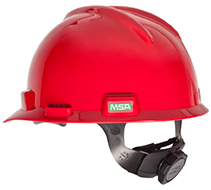Hard hat
Hard hat is a type of helmet predominantly used in workplace environments, such as construction sites, to protect the head from injury due to falling objects, impact with other objects, debris, rain, and electric shock. Hard hats are a fundamental component of personal protective equipment (PPE).
History[edit | edit source]
The concept of the hard hat was introduced in the early 20th century, following the rising industrialization and the subsequent increase in workplace accidents. The first widespread use of hard hats was during the construction of the Golden Gate Bridge, which began in 1933. The project's chief engineer, Joseph Strauss, was committed to safety, mandating that workers wear hard hats, a novel idea at the time.
Design and Types[edit | edit source]
Hard hats are designed to provide protection by reducing the force of impact from falling objects or other hazards. They consist of a hard outer shell and a suspension system inside the hat that acts as a shock absorber. The space between the shell and the wearer's head reduces the impact of any blow to the top of the head.
There are two primary types of hard hats, classified by the level of protection they provide from electrical hazards:
- Type I hard hats are designed to reduce the force of impact resulting from a blow only to the top of the head.
- Type II hard hats are designed to provide protection against lateral blows as well as top blows.
Hard hats are further classified into three classes based on their electrical insulation performance:
- Class G (General) hard hats are designed to reduce the danger of contact with low-voltage conductors and offer protection up to 2,200 volts.
- Class E (Electrical) hard hats are tested to withstand 20,000 volts, providing significant protection from electrical hazards.
- Class C (Conductive) hard hats do not offer protection against electrical hazards.
Materials[edit | edit source]
Initially, hard hats were made from steels but have since evolved to be manufactured from lightweight, high-density polyethylene (HDPE) or polycarbonate. These materials provide a good balance between protection, durability, and comfort.
Usage[edit | edit source]
Hard hats are mandatory on construction sites and in any environment where there is a risk of head injury from falling objects or electrical hazards. They are also commonly used in mining, manufacturing, and any industrial setting where safety regulations require head protection.
Maintenance and Replacement[edit | edit source]
Hard hats should be regularly inspected for cracks, dents, and any damage that could compromise their protective capability. They should be replaced after a significant impact or according to the manufacturer's recommendations, as the materials can degrade over time, especially when exposed to sunlight or chemicals.
Regulations[edit | edit source]
In many countries, the use of hard hats is mandated by law or regulations set by occupational health and safety organizations. In the United States, the Occupational Safety and Health Administration (OSHA) sets standards for head protection in the workplace, specifying the types of hard hats that must be used in various settings.
Conclusion[edit | edit source]
The hard hat is an essential piece of safety equipment that has undoubtedly saved countless lives since its introduction. Its design and materials have evolved over the years, but its purpose remains the same: to protect workers from head injuries in hazardous work environments.
This safety related article is a stub. You can help WikiMD by expanding it.
Navigation: Wellness - Encyclopedia - Health topics - Disease Index - Drugs - World Directory - Gray's Anatomy - Keto diet - Recipes
Search WikiMD
Ad.Tired of being Overweight? Try W8MD's physician weight loss program.
Semaglutide (Ozempic / Wegovy and Tirzepatide (Mounjaro) available.
Advertise on WikiMD
WikiMD is not a substitute for professional medical advice. See full disclaimer.
Credits:Most images are courtesy of Wikimedia commons, and templates Wikipedia, licensed under CC BY SA or similar.
Contributors: Prab R. Tumpati, MD





